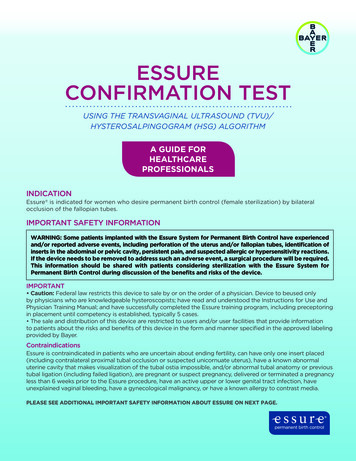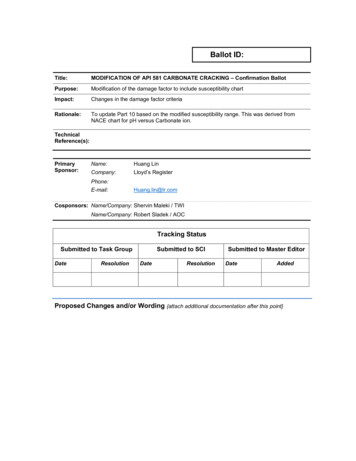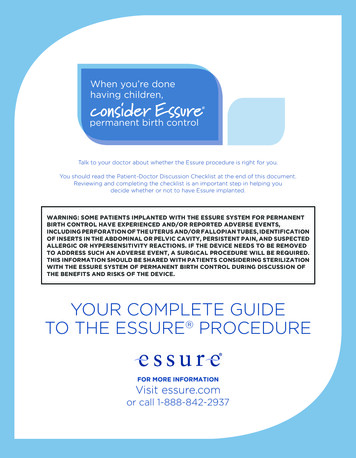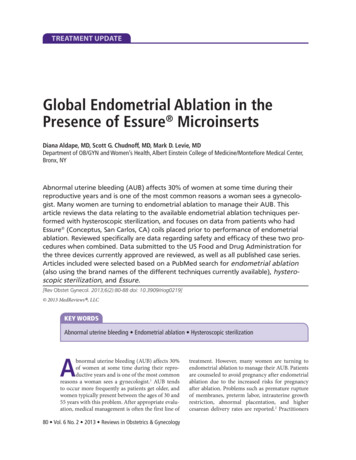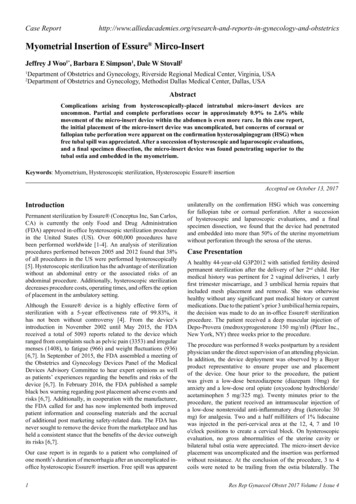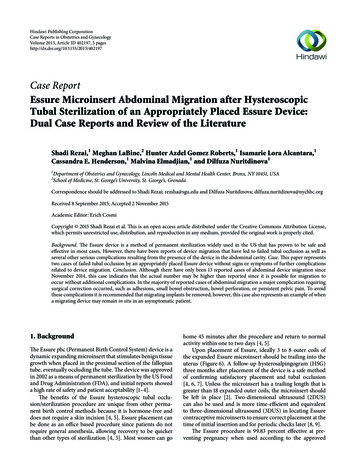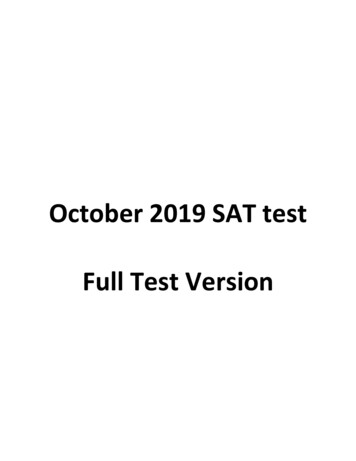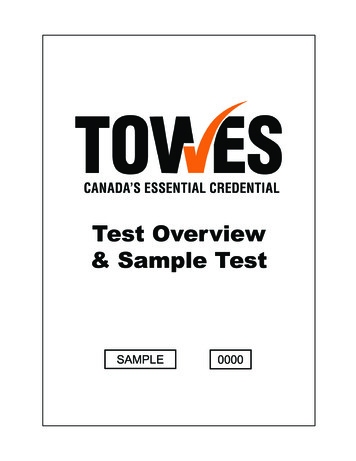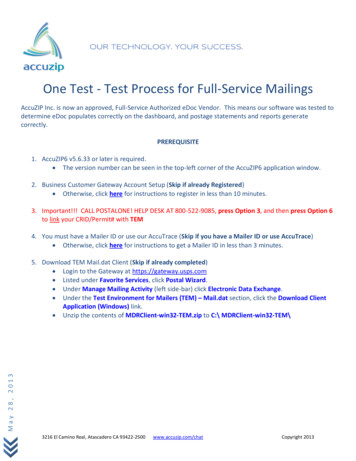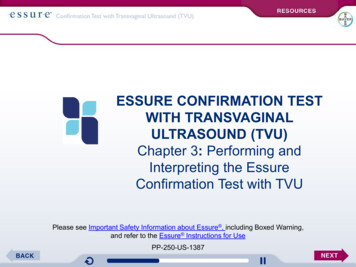
Transcription
ESSURE CONFIRMATION TESTWITH TRANSVAGINALULTRASOUND (TVU)Chapter 3: Performing andInterpreting the EssureConfirmation Test with TVUPlease see Important Safety Information about Essure , including Boxed Warning,and refer to the Essure Instructions for UsePP-250-US-1387
eLEARNING MODULE: CHAPTERSOverview of theEssure TVU/HSGConfirmation TestAlgorithmUnderstanding anEssure ConfirmationTest with TVUPerforming andInterpreting the EssureConfirmation Test withTVU123Example of TVUConfirmation TestPlease see Important Safety Information about Essure , including Boxed Warning,and refer to the Essure Instructions for Use
CHAPTER 3: PERFORMING AND INTERPRETINGTHE ESSURE CONFIRMATION TEST WITH TVUPerformingthe EssureConfirmation Testwith TVUInterpretingthe EssureConfirmation Testwith TVUPlease see Important Safety Information about Essure , including Boxed Warning,and refer to the Essure Instructions for Use
BEFORE PROCEEDING WITH THEESSURE CONFIRMATION TEST WITH TVUReview: Essure TVU/HSG Confirmation TestAlgorithm Essure placement procedure noteConfirm patient is an appropriatecandidate for a TVU Confirmation TestPlease see Important Safety Information about Essure , including Boxed Warning,or refer to the Essure Instructions for Use, in the Resources tabPlease see Important Safety Information about Essure , including Boxed Warning,and refer to the Essure Instructions for Use
DOCUMENTATION REQUIREMENTSTVUScout ImageTVUConfirmationTest(3 monthspostplacement)Capture a Minimum of3 Required ImagesImage ofLeft InsertImage ofRight InsertPlease see Important Safety Information about Essure , including Boxed Warning,and refer to the Essure Instructions for Use
PROCEDURE STEPSFor a transvaginal sonogram, the urinary bladder is preferably emptyThe procedure can be divided into the following 3 ination of uterine size and orientationVisualization of a portion of each insertsimultaneously within the cornuaDetermination of insert location and soft tissuerelationshipsPlease see Important Safety Information about Essure , including Boxed Warning,and refer to the Essure Instructions for Use
COMPONENT 1: ORIENTATIONOrientationDetermination of UterineSize and Orientation Gently insert endovaginal probe Obtain midline sagittal view todetermine uterine orientation Note uterine orientation: Anteverted, Retroverted, or Midline Obtain right and left sagittal sweep Correct midline sagittal view includesentire endometrial stripe andendocervix Linear axis of either insert shouldNOT be visualized in midline sagittalview Suspect proximal placement iflinear axis is visualized in theuterine cavity Suspect fundal perforation iflinear axis is visualized in thefundal myometriumVisualization of proximal end of 1 orboth inserts in cross-section mayindicate trailing coils in uterine cavityPlease see Important Safety Information about Essure , including Boxed Warning,and refer to the Essure Instructions for Use
ORIENTATIONOrientationOrientation videois available under“Example TVUCases”Please see Important Safety Information about Essure , including Boxed Warning,and refer to the Essure Instructions for Use
COMPONENT 2: IDENTIFICATIONIdentificationVisualization of a Portion of Each InsertSimultaneously Within the Cornua(Scout Image) Goal is to visualize a portion of each insert simultaneously Within the cornua In the transverse plane At the level of the fundus Rotate probe 90 degrees from midline sagittal view to obtain transverse viewObtain transverse sweep of uterus Starting at cervix Moving to fundusAdjust probe to visualize maximum width of endometrium Ensures the transverse view is at the fundusSlight probe rotation/adjustment may be required, or gentle endovaginal pressureapplied, to improve tissue contact and visualization Please see Important Safety Information about Essure , including Boxed Warning,and refer to the Essure Instructions for Use
COMPONENT 2: IDENTIFICATION (CONT’D)IdentificationVisualization of a Portion of Each InsertSimultaneously Within the Cornua(Scout Image) A portion of each insert should be identified within the myometrium in the cornua Suspect expulsion or perforation if 0 or only 1 insert is identified Both inserts MUST be identified in the fundal transverse view to reduce risk ofduplicate imaging Linear axis of inserts should appear relatively symmetrical and on opposite sidesof the uterus Suspect uterine cavity location if the inserts are in contact with each other Location of the inserts on TVU may appear to be more distal than noted at time ofhysteroscopy due to uterine distension during placementPlease see Important Safety Information about Essure , including Boxed Warning,and refer to the Essure Instructions for Use
COMPONENT 2: IDENTIFICATION (CONT’D)Identification Capturing theTVU ScoutImageTVU Scout ImageEssureinsertsA single image In transverse or obliquetransverse view Demonstrating a portion of eachinsert in the cornua Ensure bilateral placement Reduce risk of duplicate imaging ofthe same insertEssure Instructions for Use (with TVU)Transverse Fundal ViewPlease see Important Safety Information about Essure , including Boxed Warning,and refer to the Essure Instructions for Use
IDENTIFICATIONIdentificationPlease see Important Safety Information about Essure , including Boxed Warning,and refer to the Essure Instructions for Use
COMPONENT 3: LOCATIONLocationDetermination of Insert Locationand Soft Tissue Relationships Goal is to determine the location of each insert With targeted transverse imaging To highlight soft tissue relationships Maintaining transverse orientation, angle probe to focus on either insert Obtain left/right targeted transverse image Identify linear axis of insert as a contiguous echogenic structure (will likely requireslight rotation of probe to obtain transverse or oblique transverse view) Mild pressure may be placed on abdominal wall to displace bowel andgently bring adnexa toward probe Suspect unsatisfactory location if linear axis is not visualized (coiled, bent,or elongated configuration suggested)Position of insert in the cornua and relationship with the endometrium and SUTJshould be notedPlease see Important Safety Information about Essure , including Boxed Warning,and refer to the Essure Instructions for Use
COMPONENT 3: LOCATION (CONT’D)Location Capturing Images of the Leftand Right InsertsImage of linear axis of left or right insert intransverse or oblique transverse view Labeled “left” or “right,” accordingly Demonstrates linear axis of insert crossingthe myometrium in the cornua OR incontact with the SUTJRepeat process on contralateral side and capturesecond labeled imagePlease see Important Safety Information about Essure , including Boxed Warning,and refer to the Essure Instructions for Use
COMPONENT 3: LOCATION (CONT’D)LocationEndometriumEndometriumProximal endof insertSUTJLinear axisof insertProximal endof insertSUTJLinear axisof insertTransverse Focused ViewPlease see Important Safety Information about Essure , including Boxed Warning,and refer to the Essure Instructions for UseDistalball-tip
LOCATION SUMMARY VIDEOLocationLocation video isavailable under“Example TVUCases”Please see Important Safety Information about Essure , including Boxed Warning,and refer to the Essure Instructions for Use
CLASSIFICATION OF INSERT LOCATION WITH TVUOptimalSatisfactoryOptimal or satisfactory location of bothinserts required for: Discontinuation of alternativecontraception Reliance on Essure for birthcontrolUnsatisfactoryUnsatisfactory location of inserts: Patient cannot rely on Essure for birth control and must remainon alternative contraception Patient must proceed to amodified HSG Confirmation Testto evaluate insert location andtubal occlusionPlease see Important Safety Information about Essure , including Boxed Warning,and refer to the Essure Instructions for Use
CLASSIFICATION OF INSERT LOCATION WITH TVU: OPTIMALOptimal EndometriumInsert location is optimal when: The proximal end of insert is incontact with uterine cavity orendometrium, and Linear axis is withinmyometrium in the cornua andcan be visualized at or crossingSUTJThe portion of insert in the fallopiantube may or may not be visualizedLinear axis of insert must bevisualized to confirm it is not coiledor elongatedMyometriumSUTJProximal endof insertUterine serosaEssure Instructions for Use (with TVU)Transverse Focused ViewOptimal or satisfactory location of both inserts is requiredfor discontinuation of alternative contraception andreliance on Essure for birth controlPlease see Important Safety Information about Essure , including Boxed Warning,and refer to the Essure Instructions for Use
CLASSIFICATION OF INSERT LOCATION WITH TVU:SATISFACTORYSatisfactory MyometriumProximal endof insertInsert location is satisfactory when: The proximal end of insert isdistal to endometrium, but Linear axis is withinmyometrium in the cornuaand can be visualized at orcrossing SUTJ The portion of insert in the fallopiantube may or may not be visualized Linear axis of insert must bevisualized to confirm it is not coiledor elongatedEndometriumUterine serosaSUTJCourtesy of Dr. Ian SuchetTransverse Focused ViewOptimal or satisfactory location of both inserts is requiredfor discontinuation of alternative contraception andreliance on Essure for birth controlPlease see Important Safety Information about Essure , including Boxed Warning,and refer to the Essure Instructions for Use
CLASSIFICATION OF INSERT LOCATION WITH TVU:UNSATISFACTORYUnsatisfactory Insert location is unsatisfactory if: A portion of each insert cannot be visualized in the cornua in the transverse oroblique transverse view in 1 scout image If insert location is unsatisfactory: Patient cannot rely on Essure for birth control and must remain on alternativecontraception Patient must proceed to a modified HSG Confirmation Test to evaluate insertlocation and tubal occlusionPlease see Important Safety Information about Essure , including Boxed Warning,and refer to the Essure Instructions for Use
CLASSIFICATION OF INSERT LOCATION WITH TVU:UNSATISFACTORYUnsatisfactoryDistal is SuspectedMyometriumDistal placement is suspected if: The proximal end of insert is notlocated in myometrium in thecornua and Is not crossing or in contact withSUTJInsertCourtesy of Dr. Viviane ConnorUterine serosaTransverse Focused ViewPatient cannot rely on Essure for birth control and mustremain on alternative contraception; patient must proceed tomodified HSG to evaluate insert location and tubal occlusionPlease see Important Safety Information about Essure , including Boxed Warning,and refer to the Essure Instructions for Use
CLASSIFICATION OF INSERT LOCATION WITH TVU:UNSATISFACTORYUnsatisfactoryProximal is Suspected Proximal placement is suspected if greater than 50% or majority of insert isvisualized in uterine cavity, or if linear axis of insert(s) is visualized in midline sagittalview Distal end of insert must be seen in contact with or crossing SUTJ; if distal endterminates within myometrium, proximal placement is suspectedOrientationIdentification During Orientation step (midline sagittal view), if linear axis isvisualized in uterine cavity, proximal placement should besuspected During Identification step (transverse fundal view), if inserts are incontact with each other, uterine cavity location is suspectedPlease see Important Safety Information about Essure , including Boxed Warning,and refer to the Essure Instructions for Use
CLASSIFICATION OF INSERT LOCATION WITH TVU:UNSATISFACTORYUnsatisfactoryProximal is SuspectedDistalDistalball-tipball-tipLinearLinear axisaxis ofofinsertinsertLinear axis Courtesy of Dr. Viviane ConnorTransverse Focused ViewCourtesy of Dr. Ian SuchetMidline Sagittal ViewPatient cannot rely on Essure for birth control and must remain on alternative contraception;patient must proceed to modified HSG to evaluate insert location and tubal occlusionPlease see Important Safety Information about Essure , including Boxed Warning,and refer to the Essure Instructions for Use
CLASSIFICATION OF INSERT LOCATION WITH TVU:UNSATISFACTORYUnsatisfactoryPerforation is SuspectedPerforation is suspected if: EndocervixThe linear axis of 1 or both inserts are parallelto endometrial stripe in sagittal view, orSegment of linearaxis of insertLinear axis of an insert is visualized crossingmyometrium in midline sagittal viewOrientationIdentification During Orientation step(midline sagittal view), if linearaxis of an insert is visualized infundal myometrium, fundalperforation should besuspectedDuring Identification step(transverse fundal view), if 0 oronly 1 insert is identified,expulsion or perforation shouldbe suspectedEndometrialstripeUterine serosaCourtesy of Dr. Ian SuchetMidline Sagittal ViewPatient cannot rely on Essure for birth control and must remainon alternative contraception; patient must proceed to modified HSGto evaluate insert location and tubal occlusionPlease see Important Safety Information about Essure , including Boxed Warning,and refer to the Essure Instructions for Use
CLASSIFICATION OF INSERT LOCATION WITH on is SuspectedExpulsion is suspected if: 1 or both inserts are notidentified in the cornua in atransverse view in a single TVUscout image During Identification step(transverse fundal view), if 0 oronly 1 insert is identified,expulsion or perforation shouldbe suspectedOvaryCornua with noinserts identifiedCourtesy of Dr. Ian SuchetTransverse Fundal ViewPatient cannot rely on Essure for birth control and mustremain on alternative contraception; patient must proceed tomodified HSG to evaluate insert location and tubal occlusionPlease see Important Safety Information about Essure , including Boxed Warning,and refer to the Essure Instructions for Use
CLASSIFICATION OF INSERT LOCATION WITH TVU:UNSATISFACTORYUnsatisfactory UnclassifiedPosition is unsatisfactory and unclassified if: Linear axis is not visualized or cannot be identified, suggesting a coiled, bent,or elongated configuration Surrounding soft tissue cannot be clearly defined Patient cannot rely on Essure for birth control and must remain on alternativecontraception Patient must proceed to modified HSG to evaluate insert location and tubalocclusionPlease see Important Safety Information about Essure , including Boxed Warning,and refer to the Essure Instructions for Use
CLASSIFICATION OF INSERT LOCATION WITH TVU:UNSATISFACTORYUnsatisfactoryUnclassifiedInsert is coiledEndometriumUterine serosaCourtesy of Dr. Ian SuchetOblique Transverse ViewLinear axis of insert is seen,but there are no definablesoft tissue structuresCourtesy of Dr. Viviane ConnorTransverse ViewPatient cannot rely on Essure for birth control and must remain on alternative contraception;patient must proceed to modified HSG to evaluate insert location and tubal occlusionPlease see Important Safety Information about Essure , including Boxed Warning,and refer to the Essure Instructions for Use
RECOGNIZING AND MANAGING AN EQUIVOCALOR UNSATISFACTORY TVUUnsatisfactoryIf TVU is equivocal or unsatisfactory, itis important to:Counsel patient that she cannot rely onEssure for birth control and shouldremain on alternative contraception,ANDCounsel patient that she must proceedto a modified HSG to evaluate insertlocation and tubal occlusionPlease see Important Safety Information about Essure , including Boxed Warning,and refer to the Essure Instructions for Use
Chapter 3: Performing andInterpreting the EssureConfirmation Test with TVUREVIEW QUESTIONSPlease see Important Safety Information about Essure , including Boxed Warning,and refer to the Essure Instructions for Use
QUESTION 1Which of the following must be done before proceeding with a TVUConfirmation Test? Select all correct answers.a.Inform patients about the differences between the methods, including benefits and risks(including possible increased risk of pregnancy if TVU is the only confirmation methodused).b.Review the Essure TVU/HSG Confirmation Test Algorithm.c.Confirm whether the patient is an appropriate candidate for a TVU Confirmation Test.d.Check whether insert location was evaluated by TVU immediately postinsertion; if so, thepatient will not need to undergo the Confirmation Test.Submit AnswersPlease see Important Safety Information about Essure , including Boxed Warning,and refer to the Essure Instructions for Use
EXPLANATION TO QUESTION 1StatementAnswerExplanationAInform patients about the differences between themethods, including benefits and risks (includingpossible increased risk of pregnancy if TVU is theonly confirmation method used).CORRECTInform patients about the differences between the methods,including benefits and risks (including possible increasedrisk of pregnancy if TVU is the only confirmation methodused).BReview the Essure TVU/HSG Confirmation TestAlgorithm.CORRECTCConfirm whether the patient is an appropriatecandidate for a TVU Confirmation Test.DCheck whether insert location was evaluated by TVUimmediately postinsertion; if so, the patient will notneed to undergo the Confirmation Test.Before proceeding with a TVU Confirmation Test, theprocedure note and the Essure TVU/HSG Confirmation TestAlgorithm must first be reviewed to determine whether thepatient is a candidate for a TVU Confirmation Test.CORRECTINCORRECTThe Essure Confirmation Test should be performed at 3months postplacement, even if insert location was evaluatedimmediately postinsertion or at a postprocedure visit prior to3 months postplacement.Please see Important Safety Information about Essure , including Boxed Warning,and refer to the Essure Instructions for Use
QUESTION 2Which of the following statements regarding documentation of asatisfactory Essure Confirmation Test are true? Select all correct answers.a.A minimum of 3 required images must be captured during the performance of a TVUconfirmation test at 3 months post-placement.b.The TVU scout image is a transverse fundal view demonstrating a portion of each insert inthe cornua.c.A TVU scout image is not required if transverse or oblique transverse images of the left andright inserts are captured and documented.d.The images of the left and right insert must demonstrate the linear axis crossing theinterstitial portion of the fallopian tube or in contact with the SUTJ.Submit AnswersPlease see Important Safety Information about Essure , including Boxed Warning,and refer to the Essure Instructions for Use
EXPLANATION TO QUESTION 2StatementAnswerExplanationAA minimum of 3 required images must becaptured during the performance of a TVUconfirmation test at 3 months postplacement.TRUEA minimum of 3 required images must becaptured during the performance of a TVUconfirmation test at 3 months post-placement.BThe TVU scout image is a transverse fundalview demonstrating a portion of each insertin the cornua.TRUEThe scout image demonstrates a portion of eachinsert in the cornua in a transverse or obliquetransverse view.CA TVU scout image is not required iftransverse or oblique transverse images ofthe left and right inserts are captured anddocumented.FALSEThe TVU scout image is required for documentingthe presence of 2 inserts in a single image,thereby reducing the risk of duplicate imaging ofthe same insert.TRUEThe “left” and “right” insert images demonstrate, ina transverse or oblique transverse view, the linearaxes of the inserts including the proximal endcrossing the myometrium in the cornua (interstitialportion of the fallopian tube) or in contact with theSUTJ.DThe images of the left and right insert mustdemonstrate the linear axis crossing theinterstitial portion of the fallopian tube or incontact with the SUTJ.Please see Importa
ESSURE CONFIRMATION TEST WITH TRANSVAGINAL ULTRASOUND (TVU) Chapter 3: Performing and Interpreting the Essure Confirmation Test with TVU PP-250-US-1387 Please see Important Safety Information about Essure , including Box
